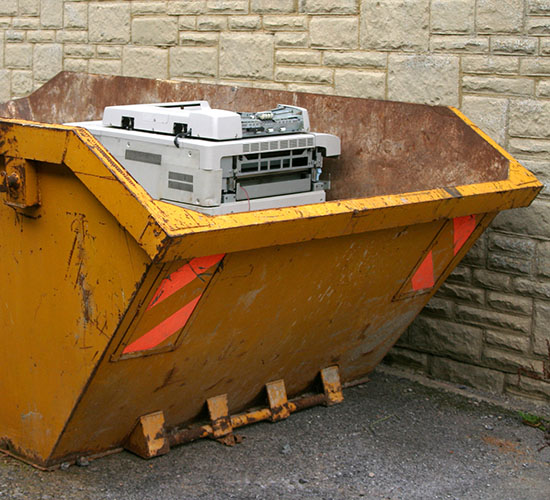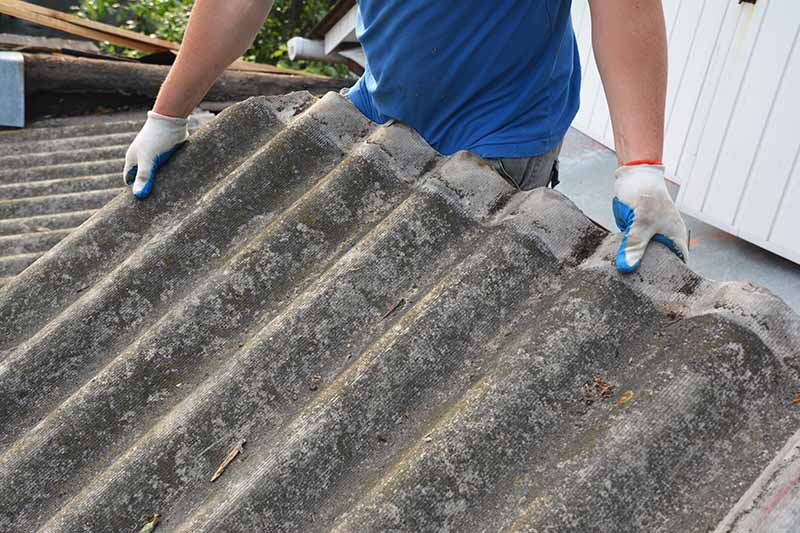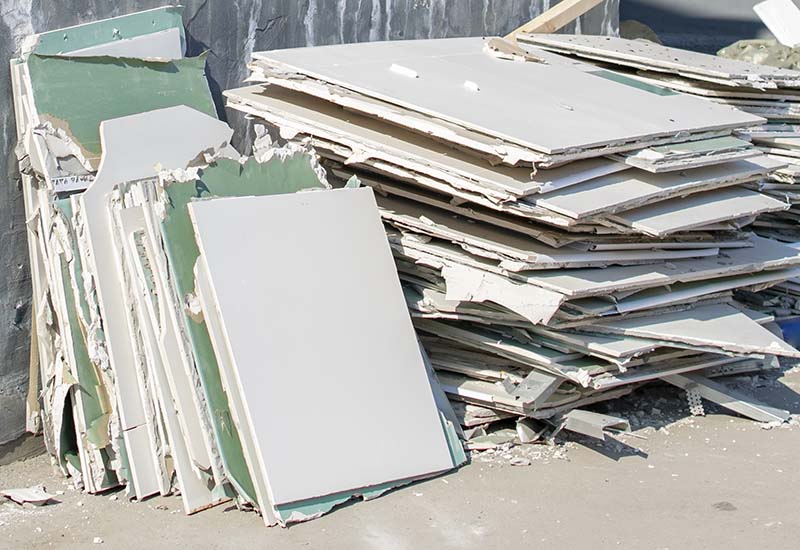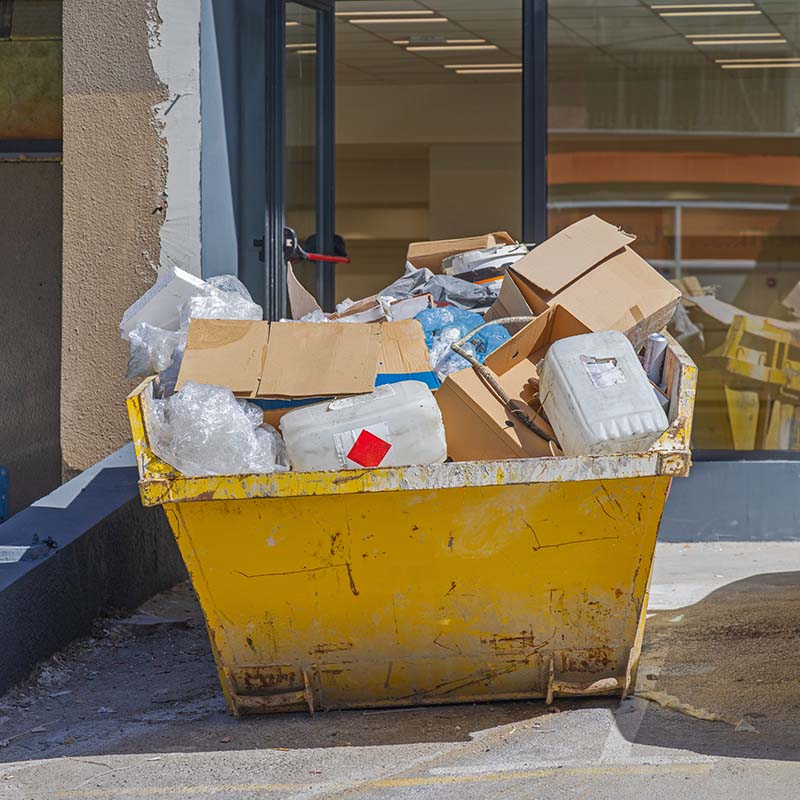Skip Hire Safety:
What Can’t You Put in a Skip, Loading & More
Skip Hire Safety:
What Can’t You Put in a Skip, Loading & More
Skips are one of the most efficient ways to remove large amounts of household waste from your home, whether you’re doing building work, clearing out your attic, or moving house. Hiring a skip is a really easy process, but knowing how to fill it correctly is important; the proper management of waste is essential for the safety of the environment and waste disposal employees.
Skips are one of the most efficient ways to remove large amounts of household waste from your home, whether you’re doing building work, clearing out your attic, or moving house. Hiring a skip is a really easy process, but knowing how to fill it correctly is important; the proper management of waste is essential for the safety of the environment and waste disposal employees.

What Can’t You Put in a Skip?
Appliances
Electrical items such as household appliances should not be put into a skip for disposal. This is because electrical wiring, motherboards, LCDs, and other components are considered hazardous waste. If an electrical appliance is damaged or gets wet, it can release lead and mercury into the surrounding area, causing risk to people and the ecosystem.
TVs, light bulbs/tubes, computers, and fridge freezers are all appliances that cannot be placed into a skip. Gas appliances (excluding gas bottles) may be disposed of via skips, but you should always check with your skip hire company before doing so.
Batteries
Similarly to appliances, batteries contain toxic substances that can be dangerous. When the structure of an alkaline battery is compromised, it can produce a liquid called potassium hydroxide. This is incredibly hazardous, and is likely to injure or kill any wildlife that comes into contact with it. For this reason, batteries should never be disposed of amongst general waste, whether in a skip or in ordinary bins. Instead, collect your used batteries and take them to a recycling centre or a supermarket drop-off point where they can be disposed of safely.
What Can’t You Put in a Skip?

Appliances
Electrical items such as household appliances should not be put into a skip for disposal. This is because electrical wiring, motherboards, LCDs, and other components are considered hazardous waste. If an electrical appliance is damaged or gets wet, it can release lead and mercury into the surrounding area, causing risk to people and the ecosystem.
TVs, light bulbs/tubes, computers, and fridge freezers are all appliances that cannot be placed into a skip. Gas appliances (excluding gas bottles) may be disposed of via skips, but you should always check with your skip hire company before doing so.
Batteries
Similarly to appliances, batteries contain toxic substances that can be dangerous. When the structure of an alkaline battery is compromised, it can produce a liquid called potassium hydroxide. This is incredibly hazardous, and is likely to injure or kill any wildlife that comes into contact with it. For this reason, batteries should never be disposed of amongst general waste, whether in a skip or in ordinary bins. Instead, collect your used batteries and take them to a recycling centre or a supermarket drop-off point where they can be disposed of safely.

Chemical Waste
Chemicals and liquid waste such as paint, cleaners, methylated spirits, drain cleaners, bleach, and laundry detergents cannot be disposed of in a skip. These chemicals are toxic to the environment, and their disposal processes are specialised to reduce the risk. Skip services do not offer this waste disposal method, and chemicals should therefore be disposed of separately.
Asbestos
Another hazardous material that should not be placed into a skip is asbestos. Widely used in construction between the 1930s and the 1970s, asbestos concrete, insulation, and sealants have a chance to appear when renovating older houses. If you find asbestos during building or repair work, you should contact a specialist company that can help you remove it safely. Do not attempt to move asbestos yourself, or place it into a skip.

Chemical Waste
Chemicals and liquid waste such as paint, cleaners, methylated spirits, drain cleaners, bleach, and laundry detergents cannot be disposed of in a skip. These chemicals are toxic to the environment, and their disposal processes are specialised to reduce the risk. Skip services do not offer this waste disposal method, and chemicals should therefore be disposed of separately.
Asbestos
Another hazardous material that should not be placed into a skip is asbestos. Widely used in construction between the 1930s and the 1970s, asbestos concrete, insulation, and sealants have a chance to appear when renovating older houses. If you find asbestos during building or repair work, you should contact a specialist company that can help you remove it safely. Do not attempt to move asbestos yourself, or place it into a skip.

Plasterboard
Plasterboard is made of gypsum, which can release hydrogen sulphide gas into the air when it breaks down. This may occur if the plasterboard gets wet during the disposal process. For this reason, you should never place plasterboard in a skip with general waste or mix it in with other materials. You can, however, use a HIPPOBAG for plasterboard removal. If you do this, make sure to segregate the plasterboard from other waste in a bag or wrapped, and ensure it stays clean and protect it from moisture.
Biohazardous waste
Biohazardous waste such as food, dog poo, medical needles, and bodily fluids should not be disposed of in a skip. Skip services are not equipped to safely handle biological waste as decomposing or infected material poses a risk to employees working at the recycling centre.

Plasterboard
Plasterboard is made of gypsum, which can release hydrogen sulphide gas into the air when it breaks down. This may occur if the plasterboard gets wet during the disposal process. For this reason, you should never place plasterboard in a skip with general waste or mix it in with other materials. You can, however, use a HIPPOBAG for plasterboard removal. If you do this, make sure to segregate the plasterboard from other waste in a bag or wrapped, and ensure it stays clean and protect it from moisture.
Biohazardous waste
Biohazardous waste such as food, dog poo, medical needles, and bodily fluids should not be disposed of in a skip. Skip services are not equipped to safely handle biological waste as decomposing or infected material poses a risk to employees working at the recycling centre.

Child Safety When Using a Skip
Often when a skip is placed on a property it generates excitement with children, especially with a large vehicle offloading the skip.
One of the issues is that it becomes a potential hazard for children who may see it as a play area. If you actively have renovations or building work taking place, they can be a hazard to themselves and to workers on the property, especially if you have heavy or loud machinery which makes it harder for workmen to notice them.
Educating and Supervising Children
It's important to educate children about the dangers associated with skips and an active building site. Explain that skips can contain sharp objects, heavy materials, and unstable piles of waste that could lead to injuries.
Supervision is crucial; always keep an eye on children when they are playing near a skip to ensure they do not climb on or enter the skip.
Establishing Safety Boundaries
Set up clear boundaries around the skip using physical barriers or visible markers. This might include cones, tape, or temporary fencing. These measures help to visually reinforce that the area around the skip is a no-go zone for children. Communicate these boundaries clearly to all children in the vicinity to prevent accidents.
Child Safety When Using a Skip

Often when a skip is placed on a property it generates excitement with children, especially with a large vehicle offloading the skip.
One of the issues is that it becomes a potential hazard for children who may see it as a play area. If you actively have renovations or building work taking place, they can be a hazard to themselves and to workers on the property, especially if you have heavy or loud machinery which makes it harder for workmen to notice them.
Educating and Supervising Children
It's important to educate children about the dangers associated with skips and an active building site. Explain that skips can contain sharp objects, heavy materials, and unstable piles of waste that could lead to injuries.
Supervision is crucial; always keep an eye on children when they are playing near a skip to ensure they do not climb on or enter the skip.
Establishing Safety Boundaries
Set up clear boundaries around the skip using physical barriers or visible markers. This might include cones, tape, or temporary fencing. These measures help to visually reinforce that the area around the skip is a no-go zone for children. Communicate these boundaries clearly to all children in the vicinity to prevent accidents.

Avoid Overloading a Skip
Understanding Weight Limits
It's essential to understand the weight restrictions specified by your skip hire company. Overloading a skip not only poses safety risks during transportation but also increases the likelihood of the skip becoming unstable. As a guide, 1 cubic yard of waste weighs 1 tonne, so a 6-yard skip will contain 6 tonnes of waste, equal to 6,000kg.
Even Distribution of Waste
Ensure the waste is evenly distributed within the skip. This practice not only aids in staying within weight limits but also contributes to the overall stability of the skip. Start by placing heavier and bulkier items at the bottom and lighter materials on top. An evenly filled skip is safer and easier to transport.
Visual Checks
Visually check to ensure that the load does not surpass the height of the skip's walls. Waste should not be piled higher than the edges of the skip, as this can lead to spillage during movement and poses a risk on roads. If you notice that the skip is approaching full capacity, consider whether it is time to arrange for a collection before adding more materials.
Avoid Overloading a Skip

Understanding Weight Limits
It's essential to understand the weight restrictions specified by your skip hire company. Overloading a skip not only poses safety risks during transportation but also increases the likelihood of the skip becoming unstable. As a guide, 1 cubic yard of waste weighs 1 tonne, so a 6-yard skip will contain 6 tonnes of waste, equal to 6,000kg.
Even Distribution of Waste
Ensure the waste is evenly distributed within the skip. This practice not only aids in staying within weight limits but also contributes to the overall stability of the skip. Start by placing heavier and bulkier items at the bottom and lighter materials on top. An evenly filled skip is safer and easier to transport.
Visual Checks
Visually check to ensure that the load does not surpass the height of the skip's walls. Waste should not be piled higher than the edges of the skip, as this can lead to spillage during movement and poses a risk on roads. If you notice that the skip is approaching full capacity, consider whether it is time to arrange for a collection before adding more materials.

Safe Filling Practices for Skips
Layering Waste Effectively
Begin filling your skip by placing the heaviest items at the bottom. This creates a stable base and prevents it becoming top heavy with light materials being under heavier debris. As you layer waste, make sure each layer is as flat and compact as possible, which helps in maximising the skip’s capacity and maintaining its stability.
Handling Sharp and Hazardous Objects
Care must be taken with sharp objects. Wrap sharp items like broken glass or jagged metal in cardboard or thick cloth to prevent them from injuring someone handling the waste.
Use a Step Ladder for Safe Loading
To safely place items into a skip and maintain an even distribution of waste, use a step ladder. This approach prevents overreaching and potential strain injuries. It also helps ensure that waste is placed carefully and compactly, which helps with the stability of the skip.
Safe Filling Practices for Skips

Layering Waste Effectively
Begin filling your skip by placing the heaviest items at the bottom. This creates a stable base and prevents it becoming top heavy with light materials being under heavier debris. As you layer waste, make sure each layer is as flat and compact as possible, which helps in maximising the skip’s capacity and maintaining its stability.
Handling Sharp and Hazardous Objects
Care must be taken with sharp objects. Wrap sharp items like broken glass or jagged metal in cardboard or thick cloth to prevent them from injuring someone handling the waste.
Use a Step Ladder for Safe Loading
To safely place items into a skip and maintain an even distribution of waste, use a step ladder. This approach prevents overreaching and potential strain injuries. It also helps ensure that waste is placed carefully and compactly, which helps with the stability of the skip.
What Kind of Skip Should I Hire
There are several sizes of skip to choose from depending on the amount of waste you need to dispose of. The size of your skip and the type of waste you put into it will determine how much your skip will weigh, how much you can fit into it, and the cost of skip removal. Consider your requirements when hiring a skip, and if you’re unsure, contact our customer service team to discuss your requirements.
What Kind of Skip Should I Hire
There are several sizes of skip to choose from depending on the amount of waste you need to dispose of. The size of your skip and the type of waste you put into it will determine how much your skip will weigh, how much you can fit into it, and the cost of skip removal. Consider your requirements when hiring a skip, and if you’re unsure, contact our customer service team to discuss your requirements.
